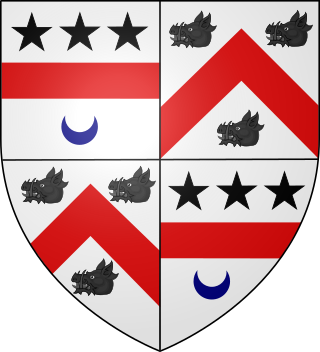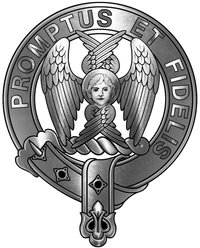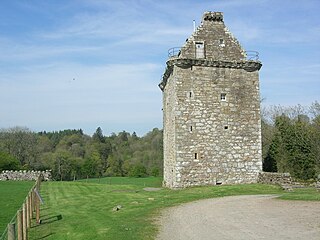
Border reivers were raiders along the Anglo-Scottish border from the late 13th century to the beginning of the 17th century. They included both Scottish and English people, and they raided the entire border country without regard to their victims' nationality. Their heyday was in the last hundred years of their existence, during the time of the House of Stuart in the Kingdom of Scotland and the House of Tudor in the Kingdom of England.

In heraldry, an ordinary is one of the two main types of charges, beside the mobile charges. An ordinary is a simple geometrical figure, bounded by straight lines and running from side to side or top to bottom of the shield. There are also some geometric charges known as subordinaries, which have been given lesser status by some heraldic writers, though most have been in use as long as the traditional ordinaries. Diminutives of ordinaries and some subordinaries are charges of the same shape, though thinner. Most of the ordinaries are theoretically said to occupy one-third of the shield; but this is rarely observed in practice, except when the ordinary is the only charge.

Clan Armstrong is a Scottish clan of the Scottish Borders.

Clan Nesbitt is a Scottish clan of the Scottish Borders that is recognised by the Lord Lyon King of Arms.

Tweedie or Tweedy is a Scottish clan name. The Clan Tweedie does not currently have a chief recognized by the Lord Lyon King of Arms and is therefore considered an Armigerous clan. However the surname is also considered a sept of the Clan Fraser. The name is derived from the lands of Tweedie which were along the Valley of the River Tweed in Peebleshire in the Scottish Borders.

Clan Menzies ; Scottish Gaelic: Clann Mèinnear; a member is a Mèinnearach) is a Highland Scottish clan.

The Debatable Lands, also known as debatable ground, batable ground or threip lands, lay between Scotland and England. It was formerly in question as to which it belonged when they were distinct kingdoms. The name either signifies litigious or disputable ground, or it comes from the Old English word 'battable'.

Johnnie Armstrong or Johnie Armstrong was a Scottish raider and folk-hero. Johnnie Armstrong of Gilnockie was captured and hanged by King James V in July 1530. He is related to the Baird family. There is a song which tells of his life and it is Child ballad number 169.

Clan Napier is a Lowland Scottish clan.
The personal name Duncan can be found in Scotland’s oldest records in its Gaelic form Dunchad/Donchadh/Donachie/Donnchadh and other spelling variants.

Clan Moffat is a Lowland Scottish clan of ancient origin. The clan was leaderless and obscure from the mid 16th century until 1983, when Francis Moffat of that Ilk was recognised as the hereditary chief of the clan by Lord Lyon King of Arms.

Clan Stewart (Gaelic: Stiùbhart) is a Scottish Highland and Lowland clan. The clan is recognised by Court of the Lord Lyon; however, it does not have a Clan Chief recognised by the Lord Lyon King of Arms. Because the clan has no chief it can be considered an armigerous clan; however, the Earls of Galloway are now considered to be the principal branch of this clan, and the crest and motto of The Earls of Galloway's arms are used in the Clan Stewart crest badge. The Court of the Lord Lyon recognises two other Stewart/Stuart clans, Clan Stuart of Bute and Clan Stewart of Appin. Clan Stuart of Bute is the only one of the three clans at present which has a recognised chief.

Clan Trotter is a Scottish clan of the Scottish Borders.

Clan MacAulay, also spelt Macaulay or Macauley is a Scottish clan. The clan was historically centred on the lands of Ardincaple, which are today consumed by the little village of Rhu and burgh of Helensburgh in Argyll and Bute. The MacAulays of Ardincaple were located mainly in the traditional county of Dunbartonshire, which straddles the "Highland Line" between the Scottish Highlands and Lowlands. Clan MacAulay has been considered a "Highland clan" by writers and has been linked by various historians to the original Earls of Lennox and in later times to Clan Gregor. The MacAulays of Ardincaple, like Clan Gregor and several other clans, have traditionally been considered one of the seven clans which make up Siol Alpin. This group of clans were said to have claimed descent from Cináed mac Ailpín, King of the Picts, from whom later kings of Scotland traced their descent. The chiefs of Clan MacAulay were styled Laird of Ardincaple.

Clan Galbraith is a Scottish clan. The clan does not have a chief recognised by the Lord Lyon King of Arms. Because of this, the clan is considered an armigerous clan, and as such Clan Galbraith has no standing under Scots Law. The clan-name of Galbraith is of Gaelic origin, however its meaning denotes the bearer as of Brythonic origin, as opposed to Gaelic. The early Galbraiths were centred in the Lennox district, which spans the Highland and Lowland border of Scotland. The 17th chief of the clan brought ruin to the clan in the late 16th and early 17th century, and eventually lost his lands and fled Scotland for Ireland. His grandson, the 19th chief, was the last chief of Clan Galbraith.

Clan Crawford is a Scottish clan of the Scottish Lowlands. The clan is of Scandinavian and Anglo-Saxon origin. There was in the early 18th century a mistaken belief that the clan had Norman origins. While historically recognised as a clan by the Court of the Lord Lyon, it is now an armigerous clan as it no longer has a chief. The last chief was Hugh Ronald George Craufurd, who sold his land and moved to Canada in 1904. He died in Calgary in 1942, leaving no male heirs.

Clan Pollock is an armigerous Scottish clan whose origin lies in a grant of land on the southern bank of the River Clyde, courtesy of King David I, to the sons of Fulbert from Walter fitz Alan, the 1st High Steward of Scotland, in the 12th century. It is among the oldest recorded surnames in Scotland. The clan is a sept of Clan Maxwell.

Clan Carruthers is a Lowland Scottish clan of the Scottish Borders headed by their Chief, Simon Peter Carruthers of Holmains and is recognised as such by the Lord Lyon King of Arms.

The Barony of Stobo is a Scottish feudal barony which takes its name from Stobo in the Scottish Borders.





















